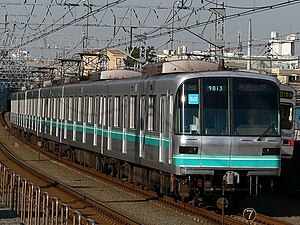Tokyo Metro 9000 series
| Tokyo Metro 9000 series | |
|---|---|

9000 series set 19 on the Tokyu Meguro Line in February 2007
|
|
| In service | 1991–Present |
| Manufacturer | Kawasaki Heavy Industries, Nippon Sharyo, Tokyu Car Corporation |
| Constructed | 1990–2009 |
| Refurbishment | 2016– |
| Number built | 138 cars (23 sets) |
| Number in service | 138 cars (23 sets) |
| Formation | 6 cars per trainset |
| Fleet numbers | 01-23 |
| Operator(s) | Tokyo Metro |
| Depot(s) | Ōji |
| Line(s) served | |
| Specifications | |
| Car body construction | Aluminium |
| Car length | 20,000 mm (65 ft 7 in) |
| Width | 2,830 mm (9 ft 3 in) |
| Doors | 4 pairs per side |
| Maximum speed | 110 km/h (70 mph) |
| Acceleration | 3.3 km/h/s |
| Deceleration |
|
| Electric system(s) | 1,500 V DC |
| Current collection method | overhead catenary |
| Safety system(s) | CS-ATC |
| Track gauge | 1,067 mm (3 ft 6 in) |
The Tokyo Metro 9000 series (東京地下鉄9000系 Tōkyō Chikatetsu 9000-kei?) is an electric multiple unit (EMU) train type operated by the Tokyo subway operator Tokyo Metro on the Tokyo Metro Namboku Line in Tokyo, Japan, since 1991.
As of 1 April 2015[update], the fleet consists of 23 six-car sets (numbered 01 to 23), all based at Oji depot in Tokyo.
A prototype four-car set was built by Kawasaki Heavy Industries in 1990 (formed of cars 9101-9201-9301-9801) for testing on the Chiyoda Line prior to the opening of the Namboku Line in 1991.
Full-production four-car sets 02 to 07 were delivered in 1991 ahead of the Namboku Line opening, followed by an additional set in 1992, set 08, to act as a spare.
The original four-car sets were reformed as six-car sets coinciding with the opening of the extension of the line from Yotsuya to Komagome on 26 March 1996. This was achieved by renumbering the centre cars (9200 and 9300) of sets 02, 04, 06, and 08 as 9600 and 9700 cars which were inserted into sets 01, 03, 05, and 07. New-build (2nd batch) intermediate cars (9200-9300-9600-9700) were then inserted into sets 02, 04, 06, and 08. The resulting minor differences led to odd-numbered sets 01 to 07 being classified as "A sets", and even-numbered sets 02 to 08 becoming "B sets".
Four new six-car sets (09 to 13) plus the four sets of four additional intermediate cars described above were built by Kawasaki Heavy Industries between 1995 and 1996, coinciding with the opening of the extension of the line from Yotsuya to Komagome in March 1996. Floor height was reduced by 5 mm compared with the 1st-batch sets from 1,155 mm to 1,150 mm. Seat width was increased from 440 mm to 450 mm.
...
Wikipedia
